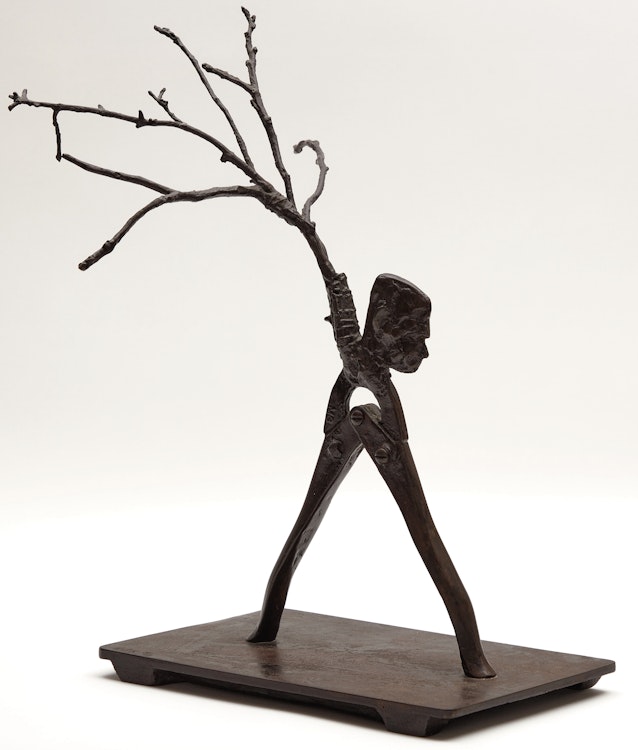from Procession (26) by William Kentridge

William Kentridge
from Procession (26)
bronze
incised with initials and numbered 3/8 on the base
16 x 13.5 x 12.5 in ( 40.6 x 34.3 x 31.8 cm ) ( overall )
Auction Estimate: $15,000.00 - $20,000.00
Price Realized $19,200.00
Sale date: May 30th 2024
Provenance:
Private Collection, Toronto
Private Collection, Toronto
Literature:
Lilian Tone, "William Kentridge: Fortuna", London, 2013, pages 13, 15 and 256
Lilian Tone, "William Kentridge: Fortuna", London, 2013, pages 13, 15 and 256
William Kentridge operates at the intersection between possibility and predetermination, describing his creative process as the concept of fortuna, which “alludes to a state of becoming wherein the work of art is endlessly under construction—even when encountered as a finished product by the viewer.” Within his rich iconographic lexicon, we discover a transmutation of everyday objects, often ones found on his studio desk: the image of a tree morphing into that of a bird or a simple coffee pot being transfigured into the shape of a diva. A procession of porters are subjected to various medium transformations; silhouettes turning from prints to objects under the artist’s direction. We view figures in altered states of being: as torn- paper constructions, shadows cast in the projection screen, or marching bronze sculptures.
His work resists a simple interpretation, existing in a constant and unpredictable flux. Only within Kentridge’s studio, where he orchestrates these meticulous "mise-en-scènes", can everything come together. As Lilian Tone, the assistant curator in the Department of Painting and Sculpture at the Museum of Modern Art, New York, describes: “By questioning rationality, embracing both the fallibility and ingenuity of human perception, and highlighting the precariousness of communication, Kentridge projects his versions of reality, time and space onto us, and dares us to project ourselves back.”
His oeuvre reveals an enduring fascination for porters and processions; of journeymen steadfastly working and marching with no clear endpoints. According to the artist, this uncertainty reflects our precarious position within modern society: “Whether it’s diaspora, whether it’s refugees, whether it’s voluntary migration—that sense of shifting across to an uncertain end at which there may be hope.” In the present work, a disembodied figure advances on spindly legs, resembling a pair of pliers. While his head is cast downward, as if resolutely advancing forward, tree-like branches sprout from the top of the structure, expanding in different directions. Kentridge’s nameless figure appears simultaneously mobile and motionless.
The elongated and emaciated form strongly resembles Alberto Giacometti’s most iconic work, "The Walking Man I", dating to 1960, evoking a similar quest to represent the very essence of human beings in all its duality and complexity. This work belongs to Kentridge’s "Procession" series, a twenty-six-piece bronze sculptural installation featuring strange characters lumbering down a narrow wooden plank. While some appear crushed by exhaustion, others seem almost joyful and dancing.
His work resists a simple interpretation, existing in a constant and unpredictable flux. Only within Kentridge’s studio, where he orchestrates these meticulous "mise-en-scènes", can everything come together. As Lilian Tone, the assistant curator in the Department of Painting and Sculpture at the Museum of Modern Art, New York, describes: “By questioning rationality, embracing both the fallibility and ingenuity of human perception, and highlighting the precariousness of communication, Kentridge projects his versions of reality, time and space onto us, and dares us to project ourselves back.”
His oeuvre reveals an enduring fascination for porters and processions; of journeymen steadfastly working and marching with no clear endpoints. According to the artist, this uncertainty reflects our precarious position within modern society: “Whether it’s diaspora, whether it’s refugees, whether it’s voluntary migration—that sense of shifting across to an uncertain end at which there may be hope.” In the present work, a disembodied figure advances on spindly legs, resembling a pair of pliers. While his head is cast downward, as if resolutely advancing forward, tree-like branches sprout from the top of the structure, expanding in different directions. Kentridge’s nameless figure appears simultaneously mobile and motionless.
The elongated and emaciated form strongly resembles Alberto Giacometti’s most iconic work, "The Walking Man I", dating to 1960, evoking a similar quest to represent the very essence of human beings in all its duality and complexity. This work belongs to Kentridge’s "Procession" series, a twenty-six-piece bronze sculptural installation featuring strange characters lumbering down a narrow wooden plank. While some appear crushed by exhaustion, others seem almost joyful and dancing.
Share this item with your friends

